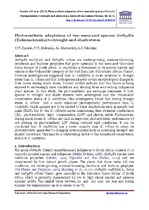Photosynthetic adaptation of two semi-arid species of Gethyllis (Kukumakranka) to drought-and-shade stress
Date
2013Author
Daniels, C.W.
Mabusela, Wilfred T.
Marnewick, Jeanine L.
Valentine, A.J.
Metadata
Show full item recordAbstract
Gethyllis multifolia and Gethyllis villosa are winter-growing, summer-blooming, deciduous and
bulbous geophytes that grow naturally in the semi-arid ‘Succulent Karoo Biome’ of South Africa.
G. multifolia is threatened in its natural habitat and resides in the ‘Vulnerable’ category of the
‘Red Data List of Southern African Plants’. Previous investigations suggested that G. multifolia is
more sensitive to drought stress than G. villosa and that both species adopted certain
morphological changes in their leaves during shade stress. Current models indicate that this
biome is being exposed to increasingly drier conditions and shading from encroaching indigenous
plant species. In this study, the photosynthetic gas exchange responses of both species to drought
and shade stresses were investigated and the ‘Vulnerable’ conservation status of G. multifolia.
This investigation found that during drought stress G. villosa had a more enhanced
photosynthetic performance than
G. multifolia which appears not to be related to foliar adaptations such as specific leaf mass
(SLM), but to the G. villosa's leaves maintaining their stomatal conductance (Gs), photosynthetic
light compensation (LCP) and photon yields. Furthermore, during shade stress G. villosa also had
an improved photosynthetic performance by not altering its photosynthetic LCP during reduced light
conditions. It can be concluded that G. multifolia has a lower capacity than G. villosa to adapt
its photosynthetic apparatus to changing environments such as increasing drought and shaded
conditions. This may be a contributing factor to the threatened conservation status of G. multifolia.

